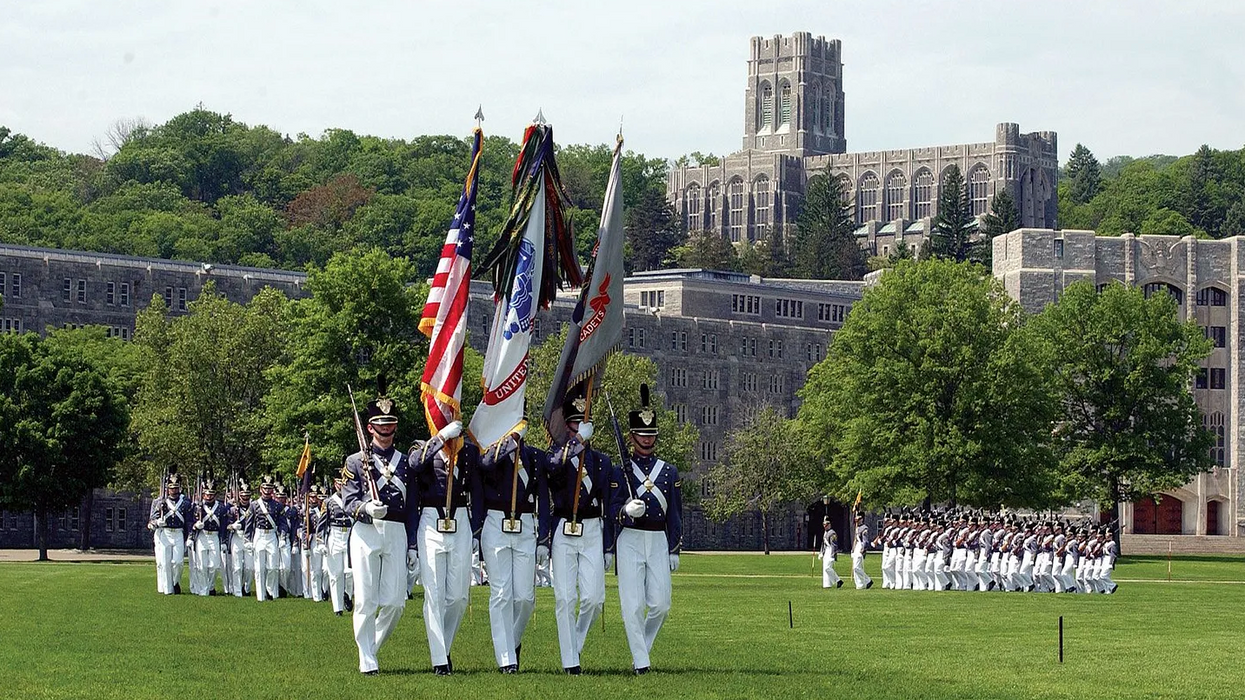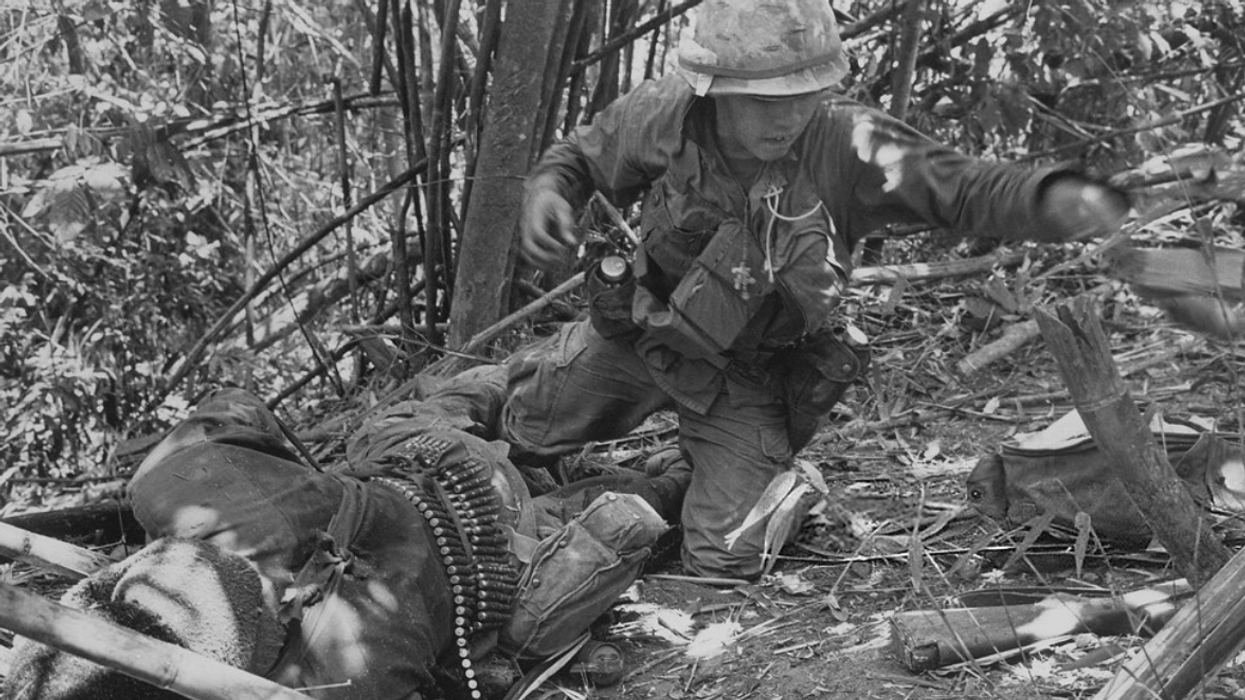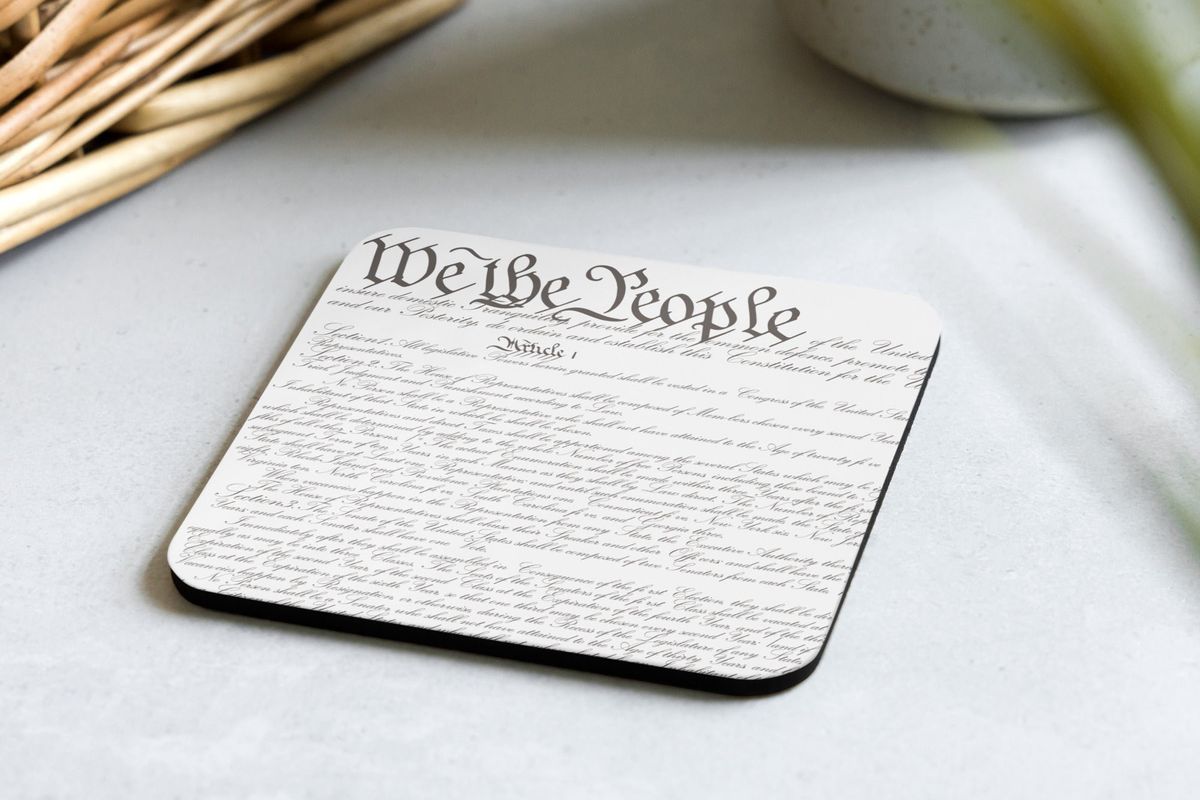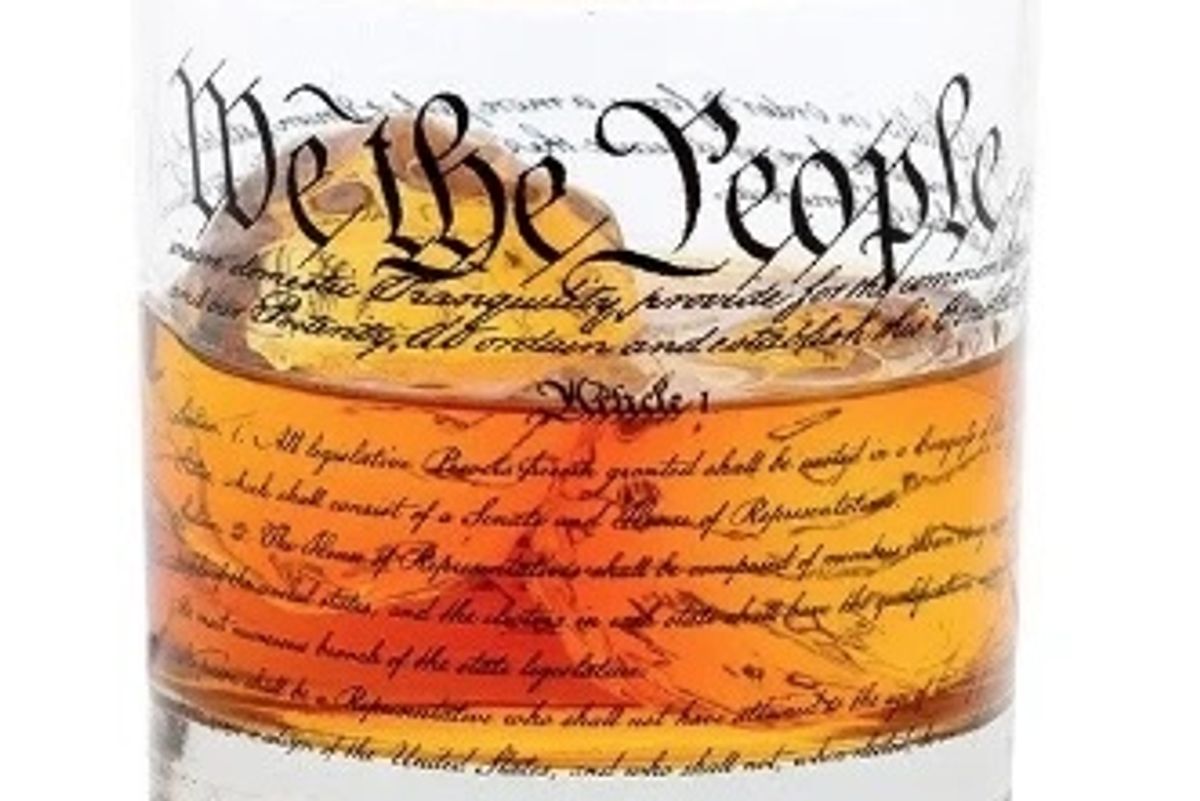Now The Trump Gang Is Coming After West Point
I have always been proud of having graduated from West Point. My family has a long connection to the Academy: my father graduated in 1945; my maternal grandfather, Bartley M. Harloe, graduated in 1918; my sixth great grandfather, Thomas Jefferson, founded the Academy in 1802; and most of all, I am proud of having played a role, along with three of my classmates, in ending the 150-year-old regulation which made mandatory for cadets to attend the weekly services of one of the three approved faiths -- Protestant, Catholic, and Jewish. No others were permitted.
At that time, failure to attend religious services was punishable by walking back and forth outside for hours with a rifle on your shoulder in the heat and freezing cold and confinement to barracks for months on end. Refusal led to a Superintendent's Board and expulsion from the Academy.
Like many institutions as old as West Point, the Academy has had many flaws, compulsory attendance at church being only one of them. Racism and antisemitism have infected West Point since its founding. During my father's time, Jewish cadets were assigned rooms by themselves, and they were “silenced” by other cadets, including their classmates, refusing to speak to them. Jewish plebes, first year cadets, were sometimes required by upperclassmen to run up and down stairs wearing their winter uniform and overcoat carrying their rifle at what was called “high port” over their heads until they dropped from heat exhaustion.
Racism was similarly rampant at West Point. The Academy did not have a Black graduate until 75 years after its founding in 1877, when Henry O. Flipper became the first African American to graduate. Flipper was silenced by other cadets and forced to live in a room by himself in the barracks and to eat by himself at a table in the mess hall throughout his four years at West Point.
There were only two other black graduates before 1936, when Benjamin O. Davis became the first Black graduate since 1889 and went on to be the first black general in the Air Force. He underwent the same brutal racist treatment that Flipper had endured -- made to eat alone at a table in the mess hall and room by himself in the barracks, silenced by most of the Corps of Cadets.
By the time I graduated, things had improved at West Point, but only marginally. I had eight Black classmates when I graduated in 1969, amounting to one percent of my class. Racism, while no longer officially endorsed by the Academy, nevertheless endured. One of my Black classmates, a star on the football team, was approached by another cadet in his company on the day Martin Luther King was assassinated in 1968. The cadet, who was white and one of our classmates, put his hand on my Black classmate’s shoulder and grinning widely said, “Well, we finally got him.”
By the time that women were first admitted to West Point in 1976, racism, while not a thing of the past, had begun to be dealt with. There were 80 black cadets in the class of 1973, for example. But the entrance of women into the previously all-male bastion of West Point disrupted the place in ways that the Academy is still dealing with. Most if not all the women in the early classes after they were admitted to West Point were sexually assaulted or raped, and sexual assaults continued for years afterward.
Racism and misogyny have persisted at the Academy. Simone Askew, the first black woman to be chosen as the top ranked cadet at West Point in 2017, wrote this about her experience as a cadet:
“It was just two weeks after I had been selected for the role of First Captain of West Point, becoming the first black woman to hold that position. It was late, and I was headed to my room. There waiting for me was a small, white note, inserted underneath my door. I opened the folded page, which bore no signature. Inside was a picture of me holding a rifle, photoshopped with a monkey's face over my own.
Though I was aware of the historical precedence of portraying black people as monkeys, I wondered if the depiction suggested something deeper about my leadership. Racing through my mind were all the presentations and conversations that I had given in the past 14 days as First Captain and whether I had made any mistakes. This self-interrogation fueled in me a paralyzing fear.
I feared if others knew how deeply such an image impacted me that I would be told -- as black cadets and officers are often told -- that this was not the first nor would it be the last time that I would experience racism, so I had better get used to it. Even worse, they would deem me as too emotional, dramatic, self-centered, weak, and ‘always making it about race.’ My strategy, instead, was to perform flawlessly. After receiving a Rhodes Scholarship, I was optimistic that I had finally done enough. My efforts, at last, would prove my humanity to the anonymous artist -- and to the entire Corps of Cadets.
However, more racist caricatures and comments continued to circulate online. One of the popular images even depicted me as Satan himself.
Am I an animal, am I a demon, or am I human?”
The document from which this statement is excerpted is a policy proposal suggesting ways that West Point might deal with the racism that persists even today. It was authored by nine graduates of the classes of 2018 and 2019 including two former cadet First Captains, two valedictorians, two Fulbright Scholars, and a Marshall Scholar, all of whom held positions of senior leadership and responsibility while they were cadets.
The proposal contains numerous suggestions for programs and classes that would, if adopted, put in practice at West Point the right wing’s boogeymen-du-jour: diversity, equity, and inclusion. I think I can safely say that if this laudable document ever came to the attention of Elon Musk and his cronies, heads would explode.
The estimable Judd Legum reported today in his “Popular Information” Substack on how the wholesale attack on DEI in the Occupational Safety and Health Administration (OSHA) has led to the “digital and physical destruction of 18 publications on workplace safety practices. Almost all of the publications are not associated with DEIA topics but appear to have been targeted because they include a DEIA-related keyword used in a completely different context.”
In one example cited by Legum, a document entitled OSHA Best Practices for Protecting EMS Responders During Treatment and Transport of Victims of Hazardous Substance Releases, the words “diverse” and “diversity” are used to describe not race or gender but rather certification and training requirements for EMS workers and how their training might keep them safe on the job.
I include this off-topic report as an example of the broad-brush approach being applied to the government-wide attack by the Trump administration on anything that might smack of promoting sane practices to deal with racism and sexism and even discrimination against the disabled in the workplace.
As I have previously reported, the Academy's panic over Trump's obsession with DEI recently led to the closure of several cadet extracurricular clubs for groups of women and minorities including the National Society of Black Engineers Club, the Society for Hispanic Professional Engineers, and the Vietnamese American Cadet Association. A friend with sources among the Academy's staff and faculty told me today that some of the clubs may be allowed to return because West Point determined that the clubs had nothing to do with the DEI office, programs, or policies. The clubs were of course just groups of cadets with similar backgrounds who wanted to get together and have fun.
The assault by the right wing on West Point and the other service academies is far from over, however. Our newly inaugurated Vice President, JD Vance, who made such a fool of himself on the world stage last week at the Munich Security Conference, when he told NATO member nations that Donald Trump will be taking the side of Russia in negotiations to end the war in Ukraine, has questioned why the United States even needs West Point or the Naval Academy or the Air Force Academy or the Coast Guard Academy. Vance and the rest of the Republican right-wing were horrified and outraged when the Supreme Court specifically exempted the service academies from its decision ending affirmative action on college campuses.
Trump and his hand puppet secretary of defense have accused the Pentagon of being filled with so-called “woke” generals and senior civil servants who amount to what they describe as a Marxist underground within the military establishment. They have even accused one of the several secretaries of defense appointed by Trump in his first administration of being a woke radical. That would be Mark Esper, a West Point graduate from the class of 1986, who they apparently believe was subjected to woke ideological pollution because his was among the first classes with female graduates. Oh, the horror that human beings of the opposite sex might take the place of the young men who had traditionally enjoyed the exclusive privilege of a West Point education!
It's hard to put into words how bad things are with Trump using the utterly bogus excuse of DEI to turn back the clock to an earlier time when white men had most of the money and all the power.
So, I'll reach back to a megalomaniac from an earlier time to put today's DEI panic in context. During my senior year when I and three of my classmates were attempting to overturn the requirement that cadets attend church every Sunday, West Point's deputy commandant singled me out as the ringleader and ordered me to get the others to cease and desist. He did this by making me come to his office every afternoon at exactly 5:05 PM for a daily lecture and verbal drubbing.
For several weeks, I would report to his office, and he would try to convince me how wrong we were and why we should withdraw our formal complaints. When I countered with our arguments about the obvious unconstitutionality of the regulation, he would leap out of his chair and come around his desk screaming at me at the top of his lungs.
He labeled me -- see if this doesn't sound familiar -- as a Communist and a Marxist and so radical that I was, in his memorable phrase, “beyond Mao.” Fed up, I replied, “Sir, you mean first is Marx, and then Lenin, and then Mao, and then Truscott?” Red-faced, his body shaking, he sputtered, “D-d-don’t you know what's going on here, you little shit?” Playing dumb and wanting to hear him answer his own question, I told him I had no idea.
“If you succeed at ending mandatory chapel, the next thing that will happen is that we'll have women in here, and then we won't have West Point anymore. All this place will be is a goddamn college.”
The name of the man who made that rather prescient prediction in October of 1968 was Alexander M. Haig, later to become Nixon’s chief of staff, Supreme Allied Commander in Europe and secretary of state.
Eight years later, the first class with women was admitted to West Point. The issue of gays in the military wasn’t on the horizon yet, and DEI didn’t even exist, but the dread threat of white men losing their grip on power had breached the sacred ramparts of West Point. Power is what the whole thing has always been about, and those with power have been crazed about holding onto it ever since.
Lucian K. Truscott IV, a graduate of West Point, has had a 50-year career as a journalist, novelist, and screenwriter. He has covered Watergate, the Stonewall riots, and wars in Lebanon, Iraq, and Afghanistan. He is also the author of five bestselling novels. You can subscribe to his daily columns at luciantruscott.substack.com and follow him on Twitter @LucianKTruscott and on Facebook at Lucian K. Truscott IV.
Reprinted with permission from Lucian Truscott Newsletter. Please consider subscribing.












